Artificial Intelligence and Its Relevance to the Aeronautical Manufacturing Industry
Info: 10119 words (40 pages) Dissertation
Published: 9th Dec 2019
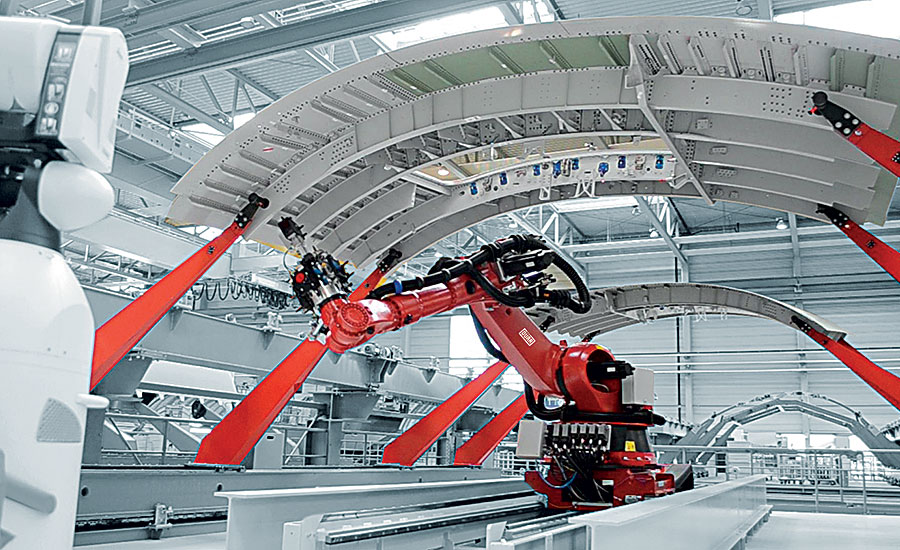 |
Abstract:
The world we live in is constantly moving into amore digital direction; products that were usual seen in hard copy format is now being produced in some form of digital design. For instance, apps and websites, are simple examples of digitals movements nonetheless they have naturally imbedded into an individual’s daily routine and life style. It is arguable to say humanity relies on the easy digital access in order to make their life easier. Is it, easier to find a recipe online then going to a bookshop and purchasing a recipe book? Is it, less time consuming to complete an online grocery then physically visiting then supermarket? These questions are easy to answer as they are simple forms of digital design that majority of society can relate to.
However, there are much more advanced forms of digital direction, such as, Artificial Intelligence (AI). Artificial intelligences, is computers coded to mimic the human behaviors but to what extents do these prediction travel to. Experts discuss the future of Artificial intelligence, their theories and estimations question the human intelligences and whether computers outperform the human mind. Artificial intelligence has been an intense discussion over the last few years, and as society grows, artificial intelligence is being seen much more. Many industries and businesses are benefiting from artificial intelligences especially the, Aeronautical Manufacturing Industry.
The Introduction:
1.1 Project Background
It is not an assumption to say society is moving towards more of an artificial intelligence direction. Today’s generations we see how “growing volume of artificial intelligence work has made new developments” as mentioned by (Robinson sighted in ComputerWorld, 1980), we see effects of AI (artificial intelligence) and how it can benefit society. However, as much as it is important to notice the positives of AI, it is reckless to not mention the negatives and risk AI can implement. In this project I will be explaining the relevance to using AI (artificial Intelligence) in the Manufacturing of the Aeronautical Industry. I will be explaining the key benefits and of disadvantages of using AI (artificial Intelligence). This project will include extensive research on AI (Artificial Intelligence), how it is used, the costing of using AI in Industry, What applications it is used in this present time, the main advantages and disadvantage so using AI (Artificial Intelligence) and the most important point is to find the relevance of using Artificial Intelligence and its relevance to manufacturing in the Aeronautical Industry.
1.2 Reasons for undertaking the work:
1.3 What is Artificial Intelligence?
ComputerWorld release an article in 1991, that clearly portray a long-standing definition for artificial intelligences, “AI is a group of technologies that attempt to emulate certain aspects of human behaviour, such as reasoning and communicating, as well as to mimic biological senses, including seeing and hearing.” (ComputerWorld, 1991). Simply, artificial intelligence is defined to be a coding system where computers/machines are able to copies human behaviours and perform task originally fulfilled by humans. There many forms of artificial intelligences some are much more advanced than others, as suggested by Kaplan, “…the field of AI has grown from its infancy-playing with toy problems like tic-tac-toe and chess-into its professional adolescence-striking out for parts unknown, acquiring new skills, exploring the real world, and seeking to discover it own limits.”(kalpan,5).
Despite, AI being reflected in many forms, we are particularly going to overlook AI Systems, manufacturing, production within the Aeronautical industry. Humans need intelligence to perform tasks better. Machines only need instructions to make sure the task is done correctly and repetitively. Artificial intelligence mimics human movements in order to get the task done right. [1] Joseph Marie created the first ever programmable machinery which was done by putting instructions on punched cards. From that invention the manufacturing world has been able to save time, money and hard labour to produce goods. From this many people have created computer aided technology to complete the work for them. Including aiding in building a car, food production, making phones, etc…. So how does the AI system work and how is it put into practice? Ai must be able to copy human movement in order to do the same job. For this to happen companies who make Ai systems must monitor all factory workers and asses how every worker moves to complete the task in hand. Companies would use 3d camera systems installed on the human and around the human to store the gestures and every moment the human makes on a computer. This is then be coded into the AI computer operating system and the 3d movements are also loaded on so that whatever machinery is used can copy the humans actions. This will then be implemented in a factory chain when making products. AI cannot eliminate Human skills but can be there to aid or take over a certain production process which can save time and money and also production rate would increase as well. Humans are always going to be needed as Ai technology does not have systems in place where it would be able to check the finished product. It is only programmed to certain things repetitively and this is why humans will always be there to operate the machines and to conduct final checks.
1.4 A Description of Aeronautical Industry
The Aeronautical Industry dates back to 1903 when the Wright brothers demonstrated an airplane which had power and sustained flight (Britannica. This is where the aeronautical industry all began. The Aerospace industry includes flight and space travel, which means I will be looking to find out what AI technology is being used to create commercial, military and space aircrafts.
The Aerospace is constantly expanding and by doing this they are improving technology day by day to use in different applications of the industry, such as building rockets, military applications and also commercial flights. The manufacturing process of the Aerospace industry already used AI in building
1.5 The aims and Objectives of this project:
- The main Aim is to find the relevance of using AI in the manufacturing process of the aeronautical industry.
- The advantages and disadvantages of using AI in the Manufacturing Industry
- If AI (Artificial Intelligence) aircrafts are reliable and worthy of being airborne
- Is AI (artificial Intelligence) cost saving or more expensive
- TO understand how AI is implemented and used in Manufacturing of aircrafts.
- Is there a better way in which AI can be implemented than it already is
- How AI is used in Aerospace manufacturing compared to other industries
Objectives:
Aim 1: To carry this out, I will need to
2.0 Literature Review:
This is the part where I explain everything there is to know about AI( Artificial Intelligence). I will be researching articles, journals, books and many more sources on artificial Intelligence and how the world of Aeronautical Engineering is using it.
2.1 Artificial Intelligence
Like I explained above in the introduction, Artificial Intelligence is when a machine is coded to mimic a human’s behavior to complete a task.
What is intelligence? As Michael Negevitsky described in his book about artificial intelligence, ‘’Someone’s Intelligence is their ability to understand and learn things’’. He also described Intelligence as, ‘’ Intelligence is the ability to think and understand instead of doing things by instinct or automatically’’. So, this means that intelligence is created by humans and artificial intelligence means intelligence humans have being artificially created so that there is an output.
AI (Artificial Intelligence) has been created so that human intelligence is not needed for a machine to do the same, exact work which a human work do.
2.1.1 History of how Artificial Intelligence Began:
Alan Turing back in the early 1930’s started his scientific career and this is the very beginning of the AI (artificial intelligence) world. Alan Turing designed an ‘Automatic Computing Engine’ and
he also wrote the first program which could play chess. The Turin Imitation Game was a way to find out if a machine was intelligent or not. In the Turing Test there would be three people in the beginning. 1. Judge, 2. Male human, 3. Female human (fig 1.0), they would not be able to see each other at all. The judge would have to determine who is the female and who is the male by answering a series of questions. After determining this the male/ or female human would be replaced by a computer, so now there would be 1. Judge, 2. Female, 3. Computer (fig 1.1), all still cannot see each other. The same process applies that the judge would have to decide who is male or female by asking a series of questions, if the judge picks the computer to be male then we can say that computers are intelligent.
Fig 1.1
Fig 1.0
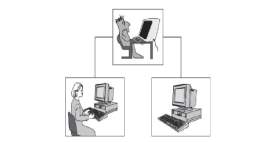
Figure 1
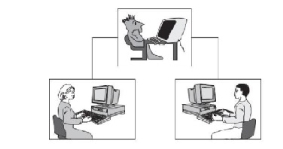
Figure 2
Even up till now, The Turing Test is still yet to pass, researchers are still trying to create computers and computer programs to try and pass this test but no one has passed and this is a good aspect because the slower the progress the better the outcome will be. Every bit of research is being created better than the last. It was originally said by Turing that he could of passed the Turing test if he had more storage on the computer but this is not the case as the modern day researchers have established.
2.1.3 The history of AI and Chess:
Playing chess on a board has always been linked to having intelligence. Having a machine play chess with a human was also a question in The Turing test and since then Claude Shannon wrote a paper describing a program which could play chess. There were two approaches on this paper to play chess, the first method would be to learn thousands of excellent moves and then use a min-max search algorithm to defeat the opponent and the second approach was a problem solving and strategic way.
Back in the 50-60 computers were very limited and so the second approach was used, this approached an algorithm as well but this algorithm was based on problem solving. This approached was less preferred as computers got faster and so the first approach was much quicker and kept up with the faster computers. Over the years the first approach had been the most popular and many competitions have been won. Making a computer think about chess moves requires intelligence, this intelligence has been imputed into an algorithm by a human for the computer to play the game. Approach A is a non-intelligence game and a very on and off approach as there is not really an algorithm inputted to make the computer think before the move in conducted.
What is a Heuristic Program?
This type of Program is used in the first approach. Heuristic means strategy, simplification and is the rule of the thumb. Researcher use this approach to solve complex problems but this approach will not always give you the solution. Heuristic approach is usually linked to a algorithmic method of solving problems. Algorithms are decisions which are created with logic and intelligence. Algorithms are the decisions made which will guarantee you the solution.
There are two types of Heuristics forms, a general purpose and a special purpose.
An example of Special Purpose Heuristics, using the heuristic program, you will be looking for one way/sequence for the queen not to be attacked, this is what is called a special purpose.
The General-purpose heuristic is a means-end analyses and planning. The means-end is an initial problem which is divided into smaller problems which are step-by step reduced. The planning step is when a simplified statement is created for the original problem. This is what is called general problem solving (GPS)
Researchers still have not identified certain questions like, how do computers learn new heuristic methods and rules and
Still more on history:
2.2: Artificial Intelligence and Manufacturing
DR Herbert Simon( one of the founders of Artificial Intelligence) said in 1965 ‘’ machines will be capable in 20 years of doing any work a man can do’’. We are living in a time where the AI technology had risen vastly and many items which we use have been manufactured by a machines, examples being mobile phones, cars, computers, toys, etc…. all these items are being assembled by machines which have been programmed to replicate a job which once a human was doing.
The Annual Manufacturing report of 2018 has stated that 92% of senior manufacturing executives believe that having smart factories will increase productivity levels and allow staff to work much smarter.
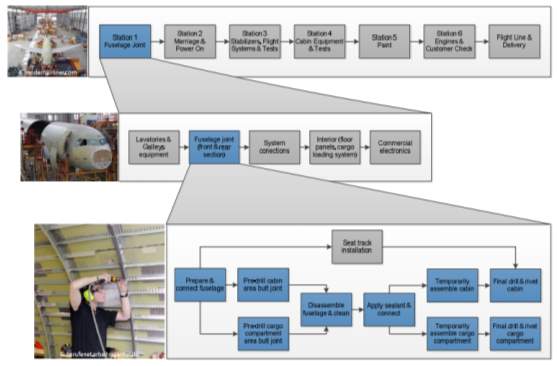
Figure 3
Figure 3 shows us the flow chart of the manufacturing and this is what robots are needed for so that all the repetitive work is no longer done by humans which will reduce the amount of work place injuries.
The mechanics of the robot
There are three stages in which the robot is set. The principle of the robot is set by acknowledging what the robot can do, such as the top of the robot arm only spins 180 degrees and the base spins 306 degrees. Then the workspace is set by setting the robot up so that its arm will only extend to a certain length and it keeps within the working boundaries. The last stage is to make the robot come to life and see how it would look. Figure 4 shows you the robot configuration and workspace environment.
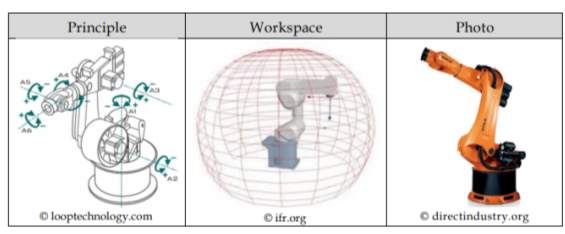
Figure 4
There are already robots and machines out there in the manufacturing world which are being used to create our everyday items, the robots have been engineered to do tasks above and beyond human capabilities, such as microscopically precise assembly. As our technology is increasing robots are finding their way in the manufacturing lines and where they are used best. Robots are not all that clever, they are programmed to do one and only 1 task and then the next task would be passed on to another robot, another point to take in to consideration is that most robots can not work around humans as they have no understanding or hurting a human and this is why in some manufacturing plants they will have cages around them. Please see figure 5.
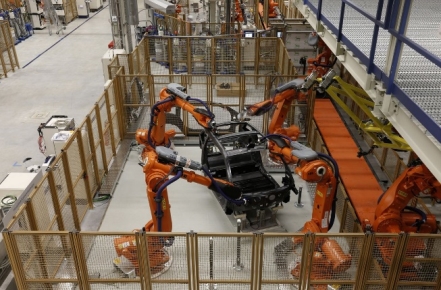
Figure 5
As you can see in figure 5 these are an assembly AI unit that are assembling a car together. The machines have to be kept in a cage facility for human safety reasons.
The world is coming into the Fourth Industrial Revolution, The first Three industrial revolutions bought us mass production and automation, now machine learning and AI (Artificial Intelligence) is opening up new opportunities and doors in the manufacturing industry.
As Greg Kinsey, Vice President of the Hitachi Insight Group said, ‘’Manufacturing is becoming less about muscle and more about brains’’.
Even when we talk about the most simplest item of AI (Artificial Intelligence), 3D printing. 3d Printers started off very basic and printing out everything in 3d made from a type of plastic and now we have 3d printers making parts of vehicles.
In this present day, we have started to rely on amazon Echo, Apples Siri and other home dives which you can talk to and give it a command to do, example, you can ask to play your favourite song and it will play it. Not many people know it but this is a form of AI (artificial Intelligence). Another example of an AI system is the ‘flipping Robot’ called the flippy the robot, this robot has taken the jobs of kitchen staff making burgers. This robot is estimated to grill around 2000 burgers a day without having breaks like most workers do. This could increase profit margins for many food businesses and decreasing the waiting times for customers food.
The History of the First Robot used in Manufacturing
George Devol designed the first ever industrial Robot back in 1954. The robot was very simple and only transferred objects from one point to another with a small distance of 12 feet. In 1956 he founded a company called Unimation to start manufacturing the robot. George Devols robot was a forerunner for all the robots researchers have created over the year up till now.
Types of robots Timeline:
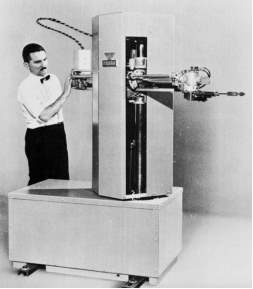 The Versatran Robot- 1958-1962: This robot was designed by Harry Johnson and Velijko and it was a cylindrical frame robotic arm design. The robot was built to grab items automatically. Please see figure 6 below.
The Versatran Robot- 1958-1962: This robot was designed by Harry Johnson and Velijko and it was a cylindrical frame robotic arm design. The robot was built to grab items automatically. Please see figure 6 below.
Figure 6
In 1961 the first ever industrial robot which was created by George Devol, was put into operation at general motors assembly line. It transported die castings from an assembly line and welded the parts onto the car. The robotic arm weighed 4000 pounds but took away one of the dangerous jobs humans had to do, which could of poised them by exhaust gas or even loose limbs. After this first robot was in operation, it took Mr Devol 5 years, doing market research and field tests, to finally start full production of the robots, he produced a number of different of robots ranging from robots which took handle materials to robots welding and doing other applications. It took Unimation ( Mr Devols company) till 1975 to show its first profit.
The three laws of robotics were, stated from the book ‘Robots in Practice’ by Engelberger’s
- A robot may not injure a human being or, through inaction, allow a human being to come to harm.
- A robot must obey the orders given to it by human beings, except where such orders would conflict with the First Law.
- A robot must protect its own existence as long as such protection does not conflict with the First or Second Laws.
AI technology used in Manufacturing in aeronautical engineering now:
Rockets ascended to space all need to be coated with a spray on material which would shield the components when the rockets is taking off into space. The spraying process was called the Marshall Convergent Coating. The only reason they use this layer of spraying is due to the Environmental Protection agency having tighter requirements.
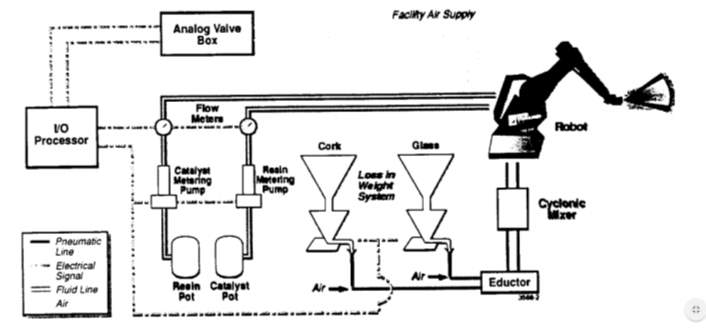
Figure 7
As you can see in Figure 7, this is the robotic Spray Gun which is used to spray this material onto parts of the Rocket.
There is a lot of back work involved in this process before the robot can start spraying the material, a human would set measuring to ensure an accurate amount of the material has been sprayed and for this to happen they installed flow Metering pumps to make sure that the amount of resin sent to the robot is the amount which was set by the human. All the material gets mixed before sent to the spray gun as well. This Spray robot will be set its own parameters as well, for example, the human would input how far the robot must spray from so the components being sprayed would receive a set amount of material thickness and the overlap patterns. This material and the way of spraying using this robot has been tested extensively and now is being used my the military in for their Titan 4 Program (rockets) and was considered for the Boeing sea launch rockets.
Back in 2015 Nasa’s Marshal Space Flight centre in Alabama installed one of the largest composites manufacturing robots created in America. This Robot will help them build the biggest, lightweight Composite parts for space vehicles ever made. This robot has all the modern technology which will help them to lower cost and reduce the time for manufacturing these components
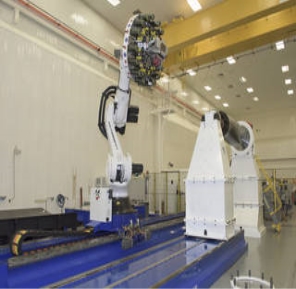
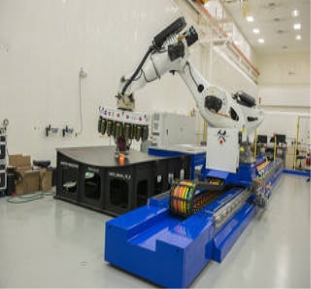
Figure 8
Figure 9
Figure 8 and 9 represents the 21-foot composite Panel Making Robot. This robot is put in place to travel on a track (the blue base in figure 6 and 7) and has the head on top (figure 7) which travels in several directions. The head of the Robot hold a maximum of 16 spools of carbon fibres. The workers(humans) will input exactly what need to be built which how much carbon fibres and then the robot would place the fibres onto a tooling machine and begin making a precise pattern to create what the human has asked. Another feature on this robot is that the head can be changed depending on what needs to be produced, so this comes very handy and makes the system very flexible. ‘This Robot will drastically reduce costs and improve the quality of large space structures’ said by John Vickers, Manager at Nasa’s National Centre for Advance Manufacturing. He also said that it will help Nasa meets the high reliability standards and having the automated digital capability will make it more precise and efficient.
May 25th 2017 a Rocket who’s engine was 3d printed was launched for the very first time. This was the first Rocket to be launched which an engine made almost entirely with a 3d printing robot. In terms of time this engine took 24 hours to print and proved efficiency and performance benefits over other systems. The advantages of a robot 3d printing an engine would be minimising the weight whilst keeping the structural performance and other advantage would be researching other complex designs.
In-orbit Manufacturing
Made in space is a company which started a project called ‘Archinaut’. This was founded back in 2010 and was known as a space manufacturing company specialising in 3d printing. As we speak there are 2, 3d robotic printers on the International Space station. They are still being test to see whether they can manufacture parts in space conditions. It has been tested on earth in a vacuum chamber with space conditions and the 3d robotic printers manufactures polymer alloy beams of up to 85 centimetres long. They are now working on a technology which robots will assembly the 3d printed components in space. The company is hoping to send the new robotic manufacturing in space technology, to space by mid 2020. This will change the robotic manufacturing concept completely is it works.
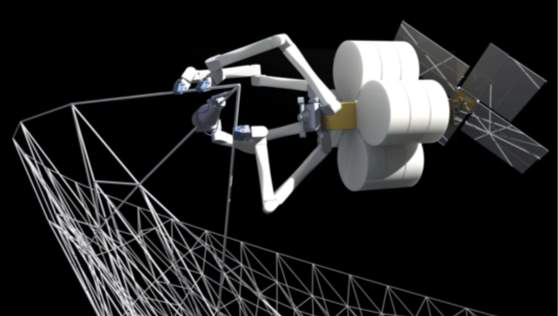 Future Manufacturing projects:
Future Manufacturing projects:
© Tethers Unlimited Inc. Artist Concept design
Figure 10
Researches are also working on a project called SpiderFab( figure 10) which would be a spider like robot in space which could help construct antennas, solar arrays and many other components which would take humans a considerable amount of time to build and send up to space.
There is also a cost benefit of manufacturing in space. There is a lot of room for improvement as manufacturing costs are very high because we build the components by hand on earth and then send it up to space, As Rob Hoyt, CEO and chief Scientist of Tethers Unlimited said, ‘It is a very expensive and time consuming process’. This project has already received two rounds of funding from the NIAC( NASA Innovative Advance Concepts) who encourage game changing ideas for space technology.
Backlogs with Aircraft production:
At the moment there are significant backlogs with aircraft productions. At this moment in time the order backlog of production is 10 years. At the end of 2017 the number of outstanding aircrafts to be built was 17,018. Last year companies produced 406 aircrafts but reaching 17,018 backlog will take time and this is why AI systems are being used more now.
Benefits of using robots in manufacturing:
It is not the case anymore for a robot to just move large parts from one place to another anymore, robots can do so much more such as welding, drilling, riveting, etc…….. using robots for aircraft production will increase production output rates, reduce the heavy overheads, improve quality of parts produced, it will improve the health and safety in the workplace, it will increase the flexibility of product manufacturing, reduce materials wasted, will not need as many workers to operate the robot, space saving in certain areas and improve quality of human workers in the factories. https://www.aero-mag.com/factories-future-robotics/
Boeing has just been granted a patent for a fully automated fuselage manufacturing plant where robots will be mobile constructing the plane. All the materials will be provided via a feeder to each robots sections. The robots will be there to joint the whole aircraft together and fasten all components, these jobs are currently being done by hand.
Manufacturing an aircraft:
Companies are now researching more into getting smart factories with include monitoring systems and AI Systems in place. Boeing have 165,000 human employees working all over the world. With the backlog at an all time high and competition high, companies are trying hard to get the manufacturing stage of the aircraft all automated. The Boeing Company started back in 196 and it is the leading manufacturer of commercial aircrafts, defence, space and security systems.
A Boeing Spokes person said, ‘’When looking at implementing automation we are focused on areas that will improve employee safety by removing ergonomic risks. We also look at build functions when automation can enhance quality and productivity. Advance manufacturing processes will enable us to meet increasing future rates by improving productivity and improving flow.’’
Boeing started early in the world of robotics as it has been using a robot paint sprayer from an earlier time. They have also notices a 40% reduction from job related injuries after using robots.( https://www.geekwire.com/2017/find-happens-boeings-machinists-team-machines/)
Different types of robots:
KUKA Robotics are a Robotics Company who have designed and built robots for all different types of industries and Aerospace.
FAUB (Fuselage Automated Upright Build):
This Robot helps manufacture the Boeing 777 aircraft. The FAUB robot works alongside humans as they are needed for manual input and the robot is there for the automation part. Humans would load and set the panels and FAUB Robots would move in unison along the barrel drilling and filling thousands of fasteners (60,000) which will connect the panels together. Humans used to do this job and repetitiveness would cause them to have long term injures on their back, neck, shoulder and arms as the work would tough and stressful. The Faub robot will also increase to speed of joining the panels together for the fuselage and improve quality as all the drilling and fastening will be done exactly the same way throughout the fuselage. ( http://www.boeing.com/features/2017/02/faub-777-assembly-02-17.page ) Boeing estimated that half of the injuries to humans on the 777 production happened on this part of the manufacturing process. All the Faub Robots can be synchronised to each other, 2 on the inside of the fuselage and 2 on the outside. All 4 will be working with each other to make sure that the whole fuselage is fastened correctly and sealed. This robot Drills, Fills and seals. Some other advantages would be that this robot can move all angles so unlike humans these robots and drill and fasten in an upright position, the other advantage would be that the quality levels are consistent and of higher quality but this can only happen when the human has set all the parameters into the computer which is controlling the Robot. One the computer has been set by the human, the robot will work non-stop until the task has been completed, this is produce the task giving at a faster rate than humans, also when the human sets the computers up the robot will not make any mistakes as it will be repetitive so this will reduce all waste as well.
The Faub system is promising an initial 50% improvement in productivity. Boeing has trailed this system which is built by KUKA systems in America. Even though this system has been tested thoroughly, Boeing still will not integrate it in completely as it is still new to them. They have had it installed in a 325,000 Sq ft factory extension and will slowly be integrated and used. https://www.aerosociety.com/news/the-magnificent-sevens/
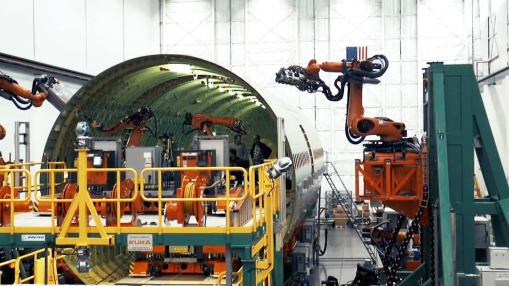
Figure 11
FANUC robotics:
This is another Company who specialises in making robots for Drilling, Riveting, coating, paint removal, welding of aluminium structures and polishing. These robots are also used to seal parts such as spars.
Drilling and fastening:
Drilling holes is the most time consuming part in the aerospace manufacturing industry. For this to be less time consuming, AI plays a massive part by reducing time and reducing a significant amount of work related injuries to humans. ‘’ A fuselage needs thousands of holes drilled and drilling them manually is not feasible’’, said by Chris Blanchette, Account manager with FANUC robotics.
It is not only drilling that is required by these robots, putting fasteners into the holes and assemble the parts together. Richardson says, ‘’ Robots drill holes very efficiently, repeatedly and to a very high degree of quality, manual drilling is difficult to do by hand, it takes a tremendous amount of skill and experience to get to the level of quality that a robot can.’’
Manual drilling can take up to 4 applications and using a robot can take 1 application for everything to be completed. In the aerospace industry, robots must do everything to the most precise work it can achieve and to reach this they must put secondary encoders. Secondary encoders also help with the reduction of time as well because the robot will be able to react more quickly in the drilling application. Using servo tracks to mount the robots has advantages but also disadvantages. Advantages would be that is increases utilisation and gives one robot access around the aircraft to do various tasks. Disadvantages would be that the flexibility would decrease because it the tracks are installed then they will be fastened into the floor, ceiling or walls, these will be permanent until the factory was to rip them out which will have a large cost attached to it. The factory will only be able to cater for one product if the servo tracks are installed in the factory. Below I have an example of a Servo Track installed into the ground of a factory and the robot mounted on top.
Manufacturers try to keep their production floor as clean as possible so that they can move the production equipment around if they have new products to build or if they feel as they could improve working efficiency and they might get new robots in which they need space for.
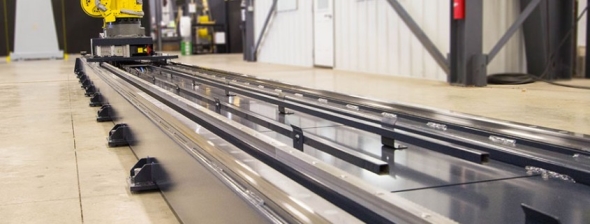
Figure 12
Jerry Fox, who is a senior engineer with Boeing Commercial said, ‘’the aerospace industry is trending away from expensive fixed tooling. Boeing likes the idea of re-deployment robots that move from one area to the next on a large aircraft.’’ Boeing currently use about 90 robots all over the world manufacture robots so they have experience with how the manufacturing process works best.
Applying and stripping paint:
The FAA (federal Aviation administration) have many guidelines on how an aircraft should be painted. There are around 12 different solutions which must be mixed together to get the correct paint for the aircraft. The paintjob of the aircraft is not just for presentation, it has other purposed such as it affects the weight of the aircraft and it protects the integrity of the airframe. It helps with corrosion and deterioration of the frame which can open the aircraft to problems. The researched document from the FAA talks states all the different mixtures needed, the different methods of applying finishes to the part, where all the work should be done and under what precaution, what air compressor to use to ensure the correct flow of paint in delivered, all the health and safety precautions, what spray guns to use on which parts, how to hold the spray gun and techniques used to apple for a top finish and the problems which can occur. ( https://www.faa.gov/regulations_policies/handbooks_manuals/aircraft/amt_airframe_handbook/media/ama_Ch08.pdf )
Using robots to spray:
The 777X Boeing aircraft wing is 106 feet long laid flat. Boeing have been using robotic painters from 2013 where inside a sealed building there are 2 robots which deal with the stripping and painting the planes wing. The new robots wash, apply solvent to remove the dirt, rinse and then spray 2 types of paint. These machines are so good that they reach the most complex areas to get to if a human was to do it. If a team of workers was to paint the wings and do all the above processes it will take them 4.5 hours to do the first coat of paint, an estimated time of 10 hours to paint the whole wing. This robot painter can achieve this task in just 24 minutes with perfection and quality. The workers who previously painted the wing were then redeployed to other areas, such as programming the machines or painting other structures which machines can not do at this time.
Previously there was only 84 jets being produced per year as the painting process was taking so long but now an extra 32 wings are being painted so it has increased the production to 100 jets a year. Figure 11( below ) shows the wing in the spray room with the robots on a track which is mounted to the floor and 2 robots are being used to spray this wing of the 777X plane. (https://www.usatoday.com/story/todayinthesky/2013/06/03/painting-robots-speed-production-of-boeing-777s/2384009/ )
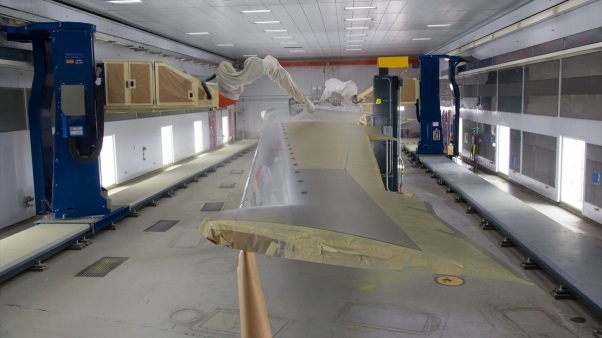
Figure 13
The robots you see above are the Kawasaki KJ314 model (figure 13). This robot has a 7-axis pedestal mainly designed for the big wings. The 7- axis designs gives this robot an additional waist which means the robots is able to rotate vertically along with its horizontal rotation.
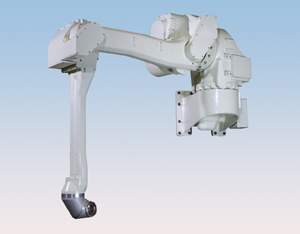
Figure 14
This robot on Kawasaki’s website as being explosion proof robot which has a 3R hollow wrist with an inner wrist diameter of 70mm to accommodate a variety of hoses. The 7th axis is the largest snbelling point for this robot as it offers a high degree of freedom to paint areas which are hard to get to. (https://robotics.kawasaki.com/en1/products/robots/painting/KJ314/ )
The PAL ( Panel Assembly Line) robot:
The Panel Assembly line (PAL) Machine makes the wings for a 737 jet. This machine rivets the wings together by gliding back and forth on tracks which are installed on the ground. It joins the upper and lower skin panels to the spars them form the wings internal structure. This machine works alongside humans as once the riveting is complete it can perform the clamping and drilling task as well. This PAL machine increases production rates by 33%. This machine has to be set with precise measurement as the wing holds all the fuel and if the machine makes a mistake then the aircraft could face major problems. (https://www.wired.com/2016/10/meet-giant-robot-builds-boeings-wings/ )
Robots used to build the 777X Boeing aircraft currently:

This is a robot which is used to lay down carbon fibre strips to create components for the 777X’s wing. (https://www.geekwire.com/2017/find-happens-boeings-machinists-team-machines/)
Figure 15
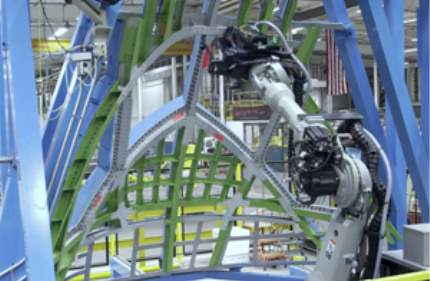 There are many different types of metal used on aircrafts so for most metals a robot will be able to drill these metals but the Yaskawa Motoman Robot ( figure 15 ), drills holes in the titanium and aluminium structures which are hard metals and normal robots will not be able to handle this.
There are many different types of metal used on aircrafts so for most metals a robot will be able to drill these metals but the Yaskawa Motoman Robot ( figure 15 ), drills holes in the titanium and aluminium structures which are hard metals and normal robots will not be able to handle this.
Figure 16
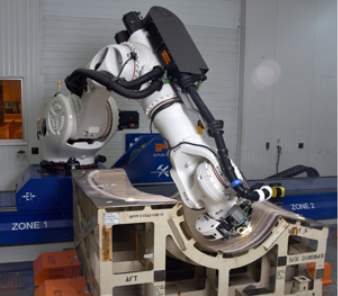 Aircrafts such as the Boeing 737 uses robots to house jet engines, this process is called Nacelles. This is a very high-force application, the robot uses a specific method called a proprietary method which creates perforations of the inner layer of the composite nacelle which will help the engine noise suppression. (figure 16)
Aircrafts such as the Boeing 737 uses robots to house jet engines, this process is called Nacelles. This is a very high-force application, the robot uses a specific method called a proprietary method which creates perforations of the inner layer of the composite nacelle which will help the engine noise suppression. (figure 16)
Figure 17
Before this robot was introduced it was all done at another factory and then bought down to the other factor. This robot has saved them nearly $4 million and allowed them to have a smaller footprint, almost 50%. This system can work in two processing zones which means whilst the robot works one part the human workers are able to prep the other parts.
This dual safety zone also allows less workplace accidents as the robots do not have to be caged up to complete tasks, these robots have special laser scanners with monitor what is around the robots, like human eyes, if the laser scanner notices anything different in the area then the robot will be slowed down or stopped before a human get injured or worse.
In Boeings New $1 billion Factory, there are also robots which assemble the wings for the Boeing 777X, These AI systems are known as Quadbots. They weight around 30,000-pound and are said to be 10 times more accurate than other automation machines which are use. This machine was developed by a company called Electroimpact (Mukilteo) are known as the global leader in Robotic and Manufacturing aircraft assembly. This machine has push the production rate to 14 aircrafts a month for the Boeing 777X Dreamliner.
The robotic arms have been built by Ku ka company and base, controls and tool head design and fully assembled by the Electroimpact company. These robots work in a team with one human robot, the robot would be on the outside of the fuselage section and the human employee will be on the inside. This machine is like the FAUB robot, its purpose is to drill and fasten the frames, door housings and other parts onto the carbon composite sections of the hull. The robot will measure holes, drill, apply the sealant and then insert the fastener. The human employee would will complete the fastening process, then the machine would measure the smoothness level before it moves on to the next. Figure 16 shows you what a Quadbot looks like.(https://www.bizjournals.com/seattle/blog/techflash/2016/03/these-30-000-pound-quadbots-built-in-mukilteo.html )
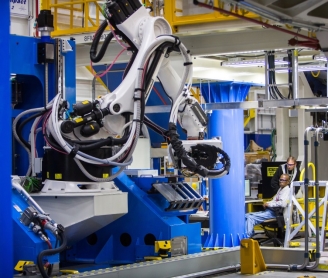
Figure 18
Figure 19(below), the Moiros Robot, is a concept design which KUKA robotics are designing. This is a concept idea for a mobile robot which can perform multiple tasks in the manufacturing industry which is collision proof. These robots will be able to attach different equipment such as grippers, tools and other specialist equipment.
The movement is described to be autonomous and collision proof. It has special laser scanners on this robots for monitoring its work environment. Its integrated software and controllers allow reliable and mobile operation.
Researchers have said that the precision of the Moiros robot works to an accuracy of 5 millimetres and has a position accuracy of +- 5mm.( http://www.expo21xx.com/news/kuka-moiros-mobile-robot/ )

Figure 19
Work Strikes:
1995 Boeings mechanists strike lasts 69 days, this was their second longest strike again Boeing. This strike formed due to the importance of job security and health insurance.
Boeing came out with its latest widebody jet the 777 in May 1995. Boeing made promises to deliver 19 of the jets that same year and another 30 jets in 1996. The mechanist union, which represented 32,500 members, tried to agree a new contract both Boeing and the union could not come to an agreement. Boeing said that if the strike went ahead then it would affect an ongoing 787 Dreamliner aircraft which was already in production and will delay its first flight. The main reason that the was union disagreeing is because Boeing said that they wanted the mechanist to pay half of their health-care cost.
Bill Johnsen who was the district president at the time in 1995 said, ‘’ How can Boeing justify the destruction of so many jobs or the slashing of health insurance coverage for workers’ families?’’
This strike was back in 1995, it did not affect Boeing as bad as the 2008 strike. In 2008 the Mechanist had a 52-day strike with shut down the commercial aircraft manufacturing at Boeing. This strike was over another pay issue and job security. After days of negotiating with the union, they finally came to an agreement which got the mechanist a 15% pay rise over 4 years and a reassurance over job security. This strike cost Boeing an estimated amount of $1.5bn (£962m) over the 52-day strike.
The workers during this strike suffered as well living of the strike pay of $150 a week. This strike did made Boeing have a shortage on aircrafts. They had a target of delivering 119 deliveries by September but were only able to deliver 84 planes which meant they were 35 planes short. (https://www.theguardian.com/business/2008/oct/29/boeing-aircraft-strike-talks )
Striking is very serious aspect in the manufacturing business and especially when you are building aircrafts. Striking can have a very long-term effect and take year to rectify the company’s reputation as it can cause severe back logs on deliveries. It can bankrupt a company and leave it in serious financial problems, just from the above case study, Boing lost $1.5bn from a 52-day strike and they had a small backlog for their delivery.
We can say when it comes to having AI systems and robots working within a manufacturing plant do not require a wage or health-care and defiantly no job security assurances. Robots are a huge investment but in the long run they do pay off and companies do not need to worry. If they had robots manufacturing planes in 2008 it might not have costed them $1.5bn and maybe significantly less. Human employees are needed to run the robots but not as many as 27,000 employees.
Costing:
Boeings plan are to invest more than $1 billion into an automation of their jet engine production. This money will go towards buying robots which drill, fasteners insertion, riveting, sealing, coating and painting applications. Also, robots which handle material, carbon fibre layup and machine operations such as deburring and shot peening.
Boeing said that automation is attractive because its main automation line now consists of a high skilled work workforce. using skilled workers comes at a very high labour cost. Boeing have also said that they can effectively build the 787 with human workers but there will be days where the humans workers will not perform to their maximum ability and they might not show up for work because of illness. These tasks of repetition will be easily done by a robot will consistency and quality without any days off. https://www.assemblymag.com/articles/92790-assembly-automation-takes-off-in-aerospace-industry
Gerould Young, who is the director of materials and manufacturing technology at Boeing research and technology, explained how automation will play a key role the company’s future, ‘’ Automation can improve our cost, quality and production rates’’.
Mr Young also has concerns and specifies that although automation has its advantages, there is a struggle of training human workers on how to operate the robots, this is a very complex task and it needs ‘’A tremendous amount of knowledge and data’’.
Manufacturers in aerospace are looking for suppliers to give them this automation for their manufacturing plants, they want to improve on accuracy, speed and quality. They want a robotic solution where robots are not fixed to the ground but are mobile and doing the work.
Ben Hemstead who is a mechanical engineer lead and chief of staff of electoimpact Inc has stated that he ‘’cannot think of an area of the assembly which is not feeling a push for automation’’. They might be a exception when it comes to the interior of the aircraft because all interiors specs depends on the aircraft produced, a high level of customised integration is required and as the materials can be quite delicate, this is where the human employee wold have the upper hand.
60% of the cost accounts for the mechanical fasteners, 80 percent of lost-time injurers and 80% of defects. These are the main areas where aerospace companies are losing money and therefore the manufacturers are considering systems where drilling and filling holes can be more efficient.
Manufacturers are researching new composite materials being used but the use of composites is making it more difficult as it causes fibre pulling an tearing. This is why researchers are trying to find automation systems which will eliminate destacking. During drilling and countersinking, damage can be caused between the two pieces of material.
Struggles with AI technology:
There are many advantages to Having AI systems in manufacturing but there are disadvantages as well. Back in 2016 the new Faub Robotic machine was paused as a lot of mistakes were appearing with the assembly and workers were made to do overtime and only 2 days off in a month to recover from this major hiccup and complete the backlog. All the work which has been unfinished has been given to be completed to the final assembly mechanics.
The workers have blamed the robotic assembly line FAUB, this is the robot which drills and fastens the fuselage panels together for the 777 Boeing jet aircraft. The executives of Boeing have denied this and said that the FAUB automation Robot was not at fault.
‘’ The distributions in the final assembly is not just caused by FAUB’’, said by the vice president, Jason Clark.
He did conclude that the robot system was very painful to set up and that the AI system is taking longer to settle in which the manufacturing line than they were expecting. Therefore, they have a major pileup of incomplete work.
One mechanic from Boeing said that the FAUB robot system was a ‘’horrible failure’’, and that they must complete its unfinished work which is pushing them to their limits.
The AI system was shut off at one point, the FAUB system was attaching the fuselage together and scored a metal skin panel, this had to be replaced. Replacing panels on huge aircrafts involve more costs and was the reason is pausing the robotic automation system. Boeing finally figured out that this was to do with a human error when the human employee was inputting data into the machine and made a mistake. After the Systems code had a minor change, an employee ran the robot with out checking the task via a simulation and to which this accident with the robot happened.
Mr Clark has also mentioned that these systems are brand new and there are bound to be hiccups as it is going through a testing period. Mr Clark also said that once the technology is debugged and matured, the AI system is going to be much faster, once the teething process is over they will get the rewards.
Boeing has a backlog of 162 777 aircrafts, they have said they will cut back production from 8.3 jets in 2016-2017 to 5.5 jets per month in 2018/2019, by this time they are going to transition to the 777X jet which has already received 306 orders.
Boeing introduced the Faub Robot to the manufacturing of the 777 jet in order iron out all the small problems and set a smooth production rate which will minimise risk for the 777X production.
The Faub Robot only produced the forward fuselage section in 2016 and Boeing are trying to get the Faub system set right so that it can produce the aft and forward section together on the same production line by 2018.
Like an infant need to learn how to walk before it can run the same principle must be applied to the robots. In another section of the Faub building, Boeing have set up another smaller operation which is to fasten together mid-body fuselage sections which will include the centre wing box and stubs of the wings. This is a much smaller operation for the robots because fastening process includes only installing 2 fasteners, which means it can be used on the outside whilst human employees attached collars on the fasteners. This is where the Quadbots are used as well.
The main goal for Boeing is to get the robots to achieve the hardest 20% of the fastening in each fuselage section. Therefore, baby steps are important and they are testing these processes with the robots by given them to do the smallest task first to perfection. The testing and qualification from the FAA (Federal Aviation Administration) should have been completed by now (2018) for it to be used.
Mr Clark stated that the robots might have produced incomplete jobs due to the system been slowed down by other engineers as they have been introduced to new work. They also had delays with the supplier (Triumph) whose employees all went on strike so Boeing did not receive enough material for the robots to use which as well meant incomplete jobs.
The 787 south Carolina Boeing Plant:
Inside the factory of the 787 manufacturing, there are 5 large robot AI systems in place which wind carbon fibre tape onto a mould which creates the composite fuselage structure.
Mike Bunker who runs the aft fuselage facility said, ‘’It does a lot more work in a lot less time’’.
There is also another robot in place which is mounted on rails to sweep around the circumference of the join so that they are able to fasten and drill the rear fuselage as they go.
https://www.bcg.com/en-gb/publications/2018/artificial-intelligence-factory-future.aspx
https://www.techemergence.com/artificial-intelligence-retail/
https://www.mckinsey.de/files/170419_mckinsey_ki_final_m.pdf
Algorithms :
Companies need Robots for manufacturing ad they are wanting high production rates, flexibility and lower cost in aircraft assembly. The main robots which are in the manufacturing field now are the ones which have articulated arms. These robots as described above are the ones which rivet, drill, weld, paint, inspections, composite fabrication, etc… Cutting out the manual repetitive work such are drilling and riveting is a must in the workplace and so robots are highly wanted and being put in place. The precision is key when it comes to riveting and drilling and with robots doing this there is a lot of coding which takes place in the background in which an algorithm is set so that the robot would follow this and so precise work.
The programming side of robots is when the user will instruct the robot by use of a specific tool centre point
http://cerasis.com/2014/10/06/robotics-in-manufacturing/
http://www.historyofinformation.com/expanded.php?id=4071
https://ntrs.nasa.gov/archive/nasa/casi.ntrs.nasa.gov/19990008827.pdf
Maintenance of the AI machines:
https://www.nasa.gov/centers/johnson/pdf/584734main_Wings-ch4h-pgs286-301.pdf
https://www.space.com/37163-3d-printed-rocket-engine-launches-new-space-exploration-era.html
https://www.sciencealert.com/3d-print-space-craft-missions-made-in-space
https://www.space.com/28846-spiderfab-space-structures-incredible-technology.html
https://www.space.com/37163-3d-printed-rocket-engine-launches-new-space-exploration-era.html
Cite This Work
To export a reference to this article please select a referencing stye below:
Related Services
View allRelated Content
All TagsContent relating to: "Artificial Intelligence"
Artificial Intelligence (AI) is the ability of a machine or computer system to adapt and improvise in new situations, usually demonstrating the ability to solve new problems. The term is also applied to machines that can perform tasks usually requiring human intelligence and thought.
Related Articles
DMCA / Removal Request
If you are the original writer of this dissertation and no longer wish to have your work published on the UKDiss.com website then please:




